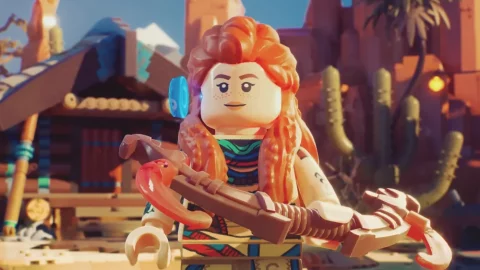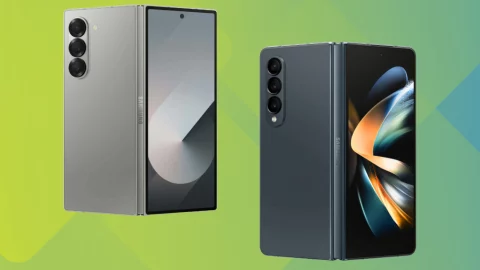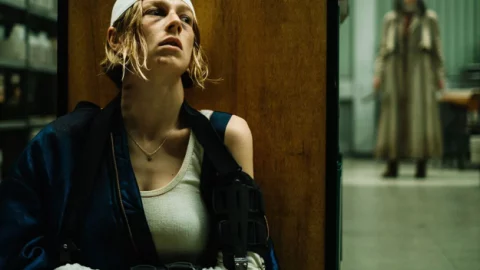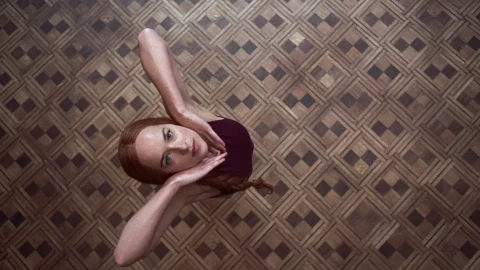
High school can be a terrifying experience. Every test has life-or-death consequences, bullies prowl the hallways like zombies, and the prospect of expulsion looms large like a guillotine. It can feel like being thrust into one of Jigsaw’s torture chambers for a young child who is having a hard time navigating the world.
Blumhouse Games’ debut publishing venture, Fear the Spotlight, capitalizes on that fear. Ordinary suburban locations are transformed into haunted houses in the tale of two girls breaking into their school to communicate with the dead. This microhorror project is based on popular teen media, such as Buffy the Vampire Slayer, but it is viewed through the prism of classic horror video games, such as Resident Evil. This establishes the mood for a spooky story of adolescent rebellion that is told using vintage puzzle box gameplay and low-fidelity graphics.
Fear the Spotlight succeeds as a piece of retro video game terror, but only with a partial credit. It is a brief creepshow that explores the psyches of both of its teenage heroines through a dual narrative twist. However, its attempts to mimic the appearance and feel of a PS1 game fall short because it still feels like a contemporary independent game dressed up as a stage prop. The disparity in tone detracts from what would otherwise be a remarkable passion project for a two-person development team.
Throwback meets modern
As Vivian and Amy slink through the hallways in pursuit of a locked Ouija board, Fear the Spotlight opens in the midst of a late-night school break-in. The two want to learn more about a terrible fire that occurred at the school a long time ago. They get their wish — but you can imagine how that goes for them. An unsettling first campaign begins with that dependable haunted house premise, as Vivian escapes a memorable monster with a spotlight for a head and learns the school’s sinister secrets through notes.
The tone falls somewhere between Silent Hill and Life is Strange, which is not always a good fit. With its ragged character models, it nearly looks the part, but a grainy TV filter is working hard to give the impression that the PS1 game is atmospheric. If you take that away, Fear the Spotlight does not look all that different from what you would anticipate from an independent game in 2024 (Crow Country this year does a much better job of capturing the look of retro horror). Instead of being a meaningful use of the visual language of the 1990s, the art style feels more like a bit of a schtick because of the imitation.
Finding the mindset that Fear the Spotlight seeks to instill in you can be challenging.
That is not to say it does not occasionally make good use of its artistic style. After the opening séance goes awry, I flee as pixelating flames devour the crunchy surroundings as fire spreads throughout the library. Bright yellow spotlights cut through the musty school as stealth sequences play. The suburban scenes are torn apart by the horror imagery, which slashes through the delicate landscape like a knife. I have the impression that I am in a decaying school where the floorboards have been rotten by decades of moral decay.
However, the tonal discrepancy frequently resurfaces, particularly in the voice acting and writing of the adventure. Even though Vivian and Amy appear to have stepped out of the amusement park in Silent Hill 3, their hammy jokes manage to defuse the tension. I am constantly caught between its 2020s attitude and its flimsy ’90s touchpoints, which makes it difficult to get a sense of time and place. Sometimes it is hard to get into the mindset that Fear the Spotlight wants you to be in.
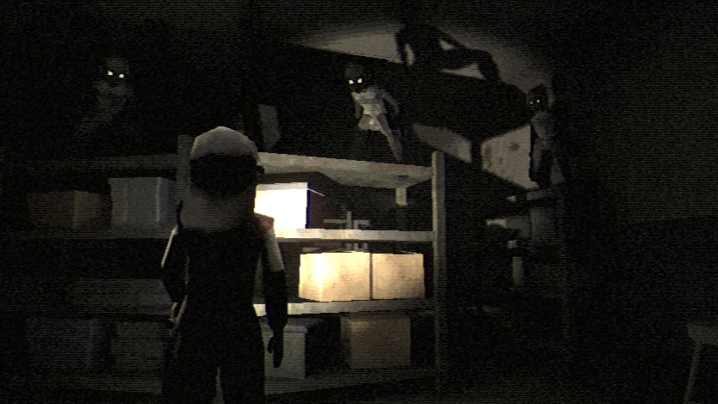
However, there are times when everything comes together. Fear the Spotlight works best as a video game equivalent of a young adult novel. It borrows the eerie set design of a psychological game such as Silent Hill, but substitutes relatable teen issues for the graphic violence and adult trauma. Bullying stories, drama club anxiety, schoolyard stalking, and other topics are all interwoven throughout the narrative. It feels like it was designed for a younger player base that may have grown up on Five Nights at Freddy’s jump scares and is looking to move on to something a little more mature but still applicable to their lives. The story may come across as an overbearing public service announcement against bullying, which is the trade-off. In one scene, a gym has been transformed into an emergency bullying assembly, complete with student-made placards outlining the negative effects of bullying.
The narrative occasionally feels jumbled as well, a peculiarity that appears to be related to the peculiar development history of the game. This is actually the second launch of Fear the Spotlight; it was originally released as a much smaller project for only a few weeks before publisher Blumhouse Games offered developer Cozy Game Pals more cash to expand it. The game’s story content was doubled, and the development team swiftly delisted it. In this version, the spotlight monster is replaced with a motherly ghoul that appears to have escaped from The Ring, and the entire second campaign moves outside of the school and concentrates more on family skeletons. Although both heroines’ stories are told in a more well-rounded manner thanks to the dual narrative, it can occasionally feel thematically disconnected, as if two stories were duct-taped together.
Extracurricular horror
The project’s bite-sized puzzle box horror largely succeeds, despite its many flaws. A childhood home turns into a surreal prison with locks and keys in the second half, while Vivian solves her way out of the school in the first two-hour campaign. This is Resident Evil in miniature. Cozy Game Pals can more successfully display their passion for ’90s horror classics with ingenious, tactile puzzles in both situations.
Fear the Spotlight is small in scope, but that works to its advantage.
In one section, I am in a gym trying to figure out how to activate the school’s air conditioning system. I have to find a few lettered fuses strewn throughout connected rooms in order to accomplish that. I have to open the fuse box, plug some cables into the proper locations, and use a nearby dial to determine the correct wattage once I locate them—which may involve searching for pumps to empty swimming pools or the misplaced handle of a bingo ball tumbler. Instead of inserting the correct key into a door, I am using a multi-part solution that involves me prodding and poking objects to interact with them.
Despite its limited reach, Fear the Spotlight has an advantage. Cozy Game Pals are able to play with some minimalist ideas that might be a drag in a longer game like Silent Hill 2. Here, for example, there is no fighting. Rather, Vivian must slink past desks to escape the stare of a searchlight. Another fantastic teen-centric twist on the classic horror formula is that if she is caught, her lungs will be damaged and she will have to use one of the few inhalers available around the school to relax. Stealthy interludes are used sparingly in a few pivotal, tension-building moments rather than overflowing the narrative. I have to save a projector transparency to a floppy disk for one of the puzzles. The monster enters the room as a lengthy progress bar begins to appear. In order to begin the lengthy process of sending it to a nearby printer, I must avoid it while the save is complete and then transfer it to a computer on the opposite side. It’s one of the few moments where Fear the Spotlight’s ’90s aesthetic gets put to good use.
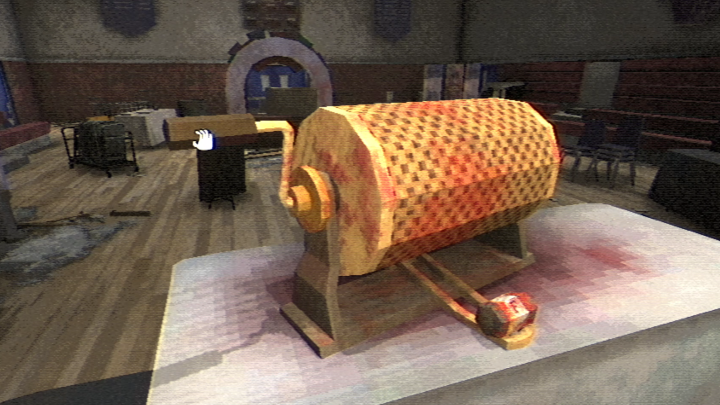
Although the puzzle loops in the second campaign are similar, new mechanics are added to give the formula a new twist. Here, my hero is reliving her family trauma while I am picking locks in a light minigame and getting jump-scared by loud cell phone notifications. Though some of that time is wasted backtracking through the same few hallways, there are just enough clever puzzles and structural twists to make for a smooth four-hour game.
A note from the studio greets me as the final, sparse credits roll by, reminding me that only two dedicated developers did most of this. The two are the first to acknowledge that their game is far from flawless; it is a brave passion project that was made possible in equal measure by Blumhouse and babysitters. Embracing all the limitations and rough edges is made easier by this moment of vulnerable sincerity. Is not that the appropriate mindset for a tale about two teenagers who find themselves in the midst of a mundane coming-of-age setting? As it navigates its nostalgic inspirations and independent flaws to establish its own identity in the horror gaming market, Fear the Spotlight exudes a charming awkwardness. I leave the eerie adventure hopeful that, like Vivian and Amy, Cozy Game Pals has emerged from the experience with a stronger hold on its identity, even though it may not reach its full potential by the end.
Fear the Spotlight was tested on Nintendo Switch OLED.

